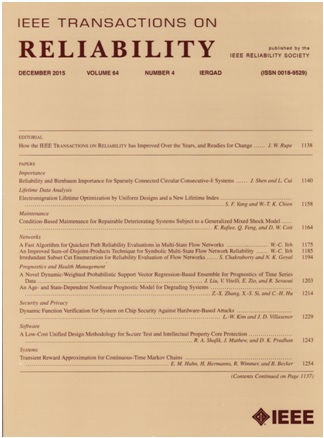A Novel Adaptive System-Level Fault Self-Diagnosis Algorithm and Its Applications
IF 5.7
2区 计算机科学
Q1 COMPUTER SCIENCE, HARDWARE & ARCHITECTURE
引用次数: 0
Abstract
With the application and rapid development of high-performance computing and cloud computing technology, the scale of the interconnection network has appeared to grow exponentially. Network attacks have become increasingly sophisticated and stealthy. To reach a high reliable network system, widespread attention has been paid to fault diagnosis. In this article, we put forward a reliable and adaptive self-diagnosis strategy, the一种新的自适应系统级故障自诊断算法及其应用
随着高性能计算和云计算技术的应用和快速发展,互联网络的规模呈指数级增长。网络攻击变得越来越复杂和隐蔽。为了实现网络系统的高可靠性,故障诊断技术受到了广泛的关注。本文提出了一种可靠的自适应自诊断策略,即$h$-额外$r$-分量条件可诊断性,用$ct_{r}^{h}(G)$表示。然后,我们给出了PMC模型下泡排序网络$B_{n}$ h$-额外$r$-分量条件可诊断性的理论推导。在此基础上,提出了一种快速、自适应的故障自诊断算法FAFD-PMC。在合成网络和真实网络中进行了大量的实验,并在准确率(ACCR)、真阴性率、假阳性率、召回率和精度方面进行了应用,证明了我们的算法的ACCR/效率。
本文章由计算机程序翻译,如有差异,请以英文原文为准。
求助全文
约1分钟内获得全文
求助全文
来源期刊

IEEE Transactions on Reliability
工程技术-工程:电子与电气
CiteScore
12.20
自引率
8.50%
发文量
153
审稿时长
7.5 months
期刊介绍:
IEEE Transactions on Reliability is a refereed journal for the reliability and allied disciplines including, but not limited to, maintainability, physics of failure, life testing, prognostics, design and manufacture for reliability, reliability for systems of systems, network availability, mission success, warranty, safety, and various measures of effectiveness. Topics eligible for publication range from hardware to software, from materials to systems, from consumer and industrial devices to manufacturing plants, from individual items to networks, from techniques for making things better to ways of predicting and measuring behavior in the field. As an engineering subject that supports new and existing technologies, we constantly expand into new areas of the assurance sciences.
 求助内容:
求助内容: 应助结果提醒方式:
应助结果提醒方式:


